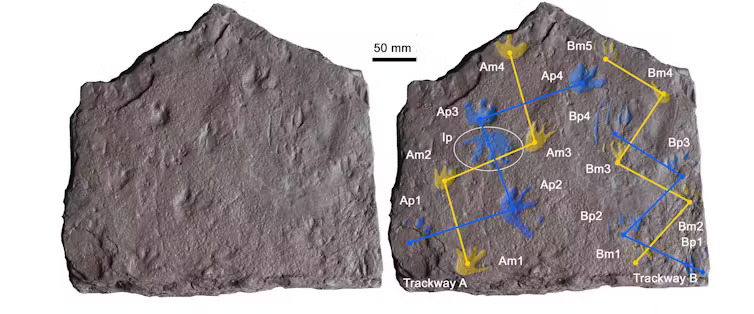Daylesford-based paleontologist Professor John Long has once again made international headlines, leading a research team that uncovered the oldest-known reptile trackways on Earth. The discovery, published this week in the prestigious journal Nature, shifts the global understanding of when vertebrates first began walking on land — and where they may have originated.
The fossilised footprints, found on a slab of sandstone near Mansfield in eastern Victoria, date back approximately 356 million years. They show the clear claw marks of an early amniote — a group that includes reptiles, birds, and mammals — and predate previously known examples by at least 40 million years.
“It’s the [evolutionary] line that leads to us,” said Professor Long. “There’s no such thing as an amphibian with well-developed, large, hooked claws. It’s a characteristic of terrestriality, because it often implies you’re climbing trees, or you need the claws for digging … that amphibians just don’t normally do.”
Long’s discovery upends long-held assumptions that the origins of land-dwelling vertebrates occurred only in the Northern Hemisphere. Until now, the earliest tetrapod fossils — the four-limbed ancestors of modern land animals — have come primarily from North America and Europe. The Mansfield find, from Australia’s portion of the ancient southern supercontinent Gondwana, suggests a deeper and more complex story.
The significance is hard to overstate. “It’s almost certain that what we have are the earliest reptile trackways,” Long said. The tracks push the timeline of reptile evolution back to the earliest Carboniferous period, a time when much of life was still confined to swampy aquatic environments.
The slab contains 18 individual footprints, including two clear trackways showing the movement of a clawed, lizard-like creature across what was once a muddy riverbank. “The sharp claws digging in the second trackway are too precise to suggest they were clawing underwater,” Long explained, responding to suggestions that the animal may have been swimming. “In our opinion, this was clearly a land-dweller.”
For Professor Long, the find has personal as well as scientific significance. “I’m so excited by this discovery because it comes from an area that I did my PhD and my honours thesis on 45 years ago,” he said. “You’ve got this big, vast area of red Carboniferous rocks in the basin there in Mansfield and you can still find world-class fossils.”
Long has spent decades studying the fossil-rich beds of eastern Victoria and has long advocated for more attention to the region’s paleontological potential. His early public talks at the Mansfield library and ongoing fieldwork helped ignite local interest in the area’s deep-time secrets.
“This trackway shows that southern continents like Gondwana played a crucial role in the early evolution of vertebrate life on land — a role that’s been largely overlooked until now,” Long said.
The publication of the research in Nature, one of the world’s most prestigious scientific journals, underscores the global importance of the find — and of the work of a scientist whose roots remain firmly planted in regional Victoria.
“Certainly, the area is so vast that there is potential to find more of these trackways or even the bones of these creatures,” Long said. “This is just the beginning.”
Professor John Long has cemented his reputation as one of Australia’s leading paleontologists – a Daylesford local whose scientific curiosity continues to shape how we understand the evolution of life on earth.
Related stories:





